The Broads Reed and Sedge Cutters Association (Brasca) was formed in March 2003 to represent the interests of self-employed reed and sedge cutters working in the Norfolk and Suffolk Broads area. This website is a point of contact for anyone seeking;
Reed and sedge cutting is seasonal work so Cutters have to diversify their skills to include wetland restoration and maintenance. Many have chainsaw and other qualifications necessary for scrub removal and tree works. Their understanding and knowledge of the marshes, waterways and the associated wildlife gives the Cutters a considerable advantage when it comes to conservation mowing and other important conservation work.
Members generally meet every 6 months and the Broads Authority are always invited to attend meetings to discuss any issues of concern and any new developments relating to harvesting reed and sedge in The Broads area. We work closely with our main customers in the thatching industry.
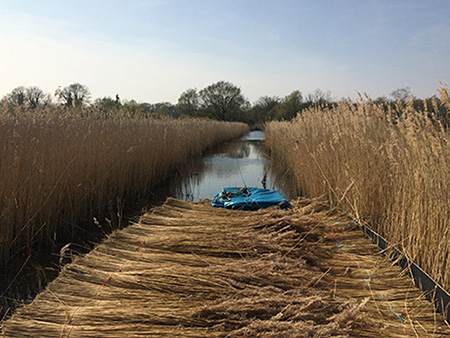
Bundles of reed being transported in a boat
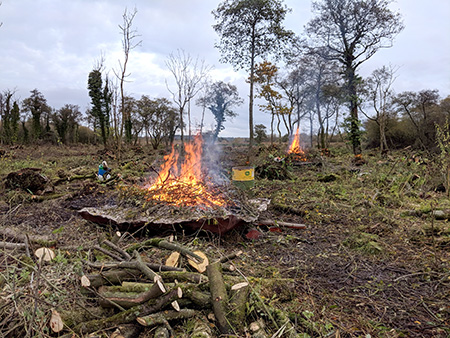
Land being cleared of scrub
Harvesting takes place every winter between December and April. Reed cutting can be either a one person job or done in organised teams depending on the method used.
Traditionally, reed was harvested using a scythe or hook with the stems cut just above ground level to capture the hardest and strongest part of the stems.
Most reed cutting today is done using machinery. Several Cutters in The Broads use small, light-weight pedestrian mowers fitted with collection boxes. These machines have the advantage of being able to cut reed or sedge and can be moved by boat or on small trailers.
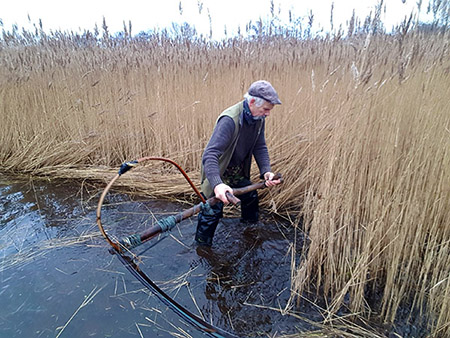
Cutting with a traditional scythe
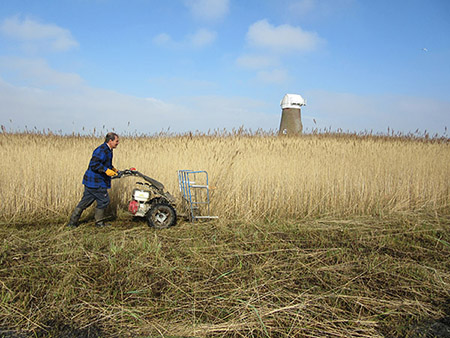
A reed cutter using a BCS reed and sedge cutting machine
Extensive reed bed sites with suitable ground conditions can permit the use of larger machinery such as the Reed Mower Binder (Olympia). These pedestrian mowers cut and tie the reed and therefore have a high work rate.
Low ground pressure, tracked machines which cut, tie and gather the reed are also used.
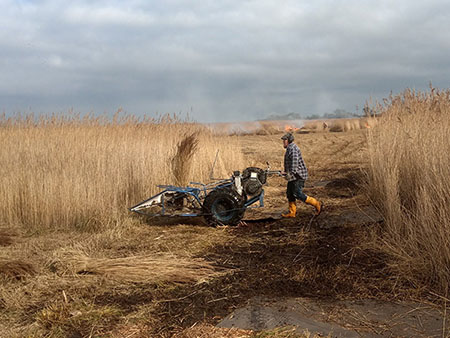
A reed cutter using an Olympia Reed Mower Binder
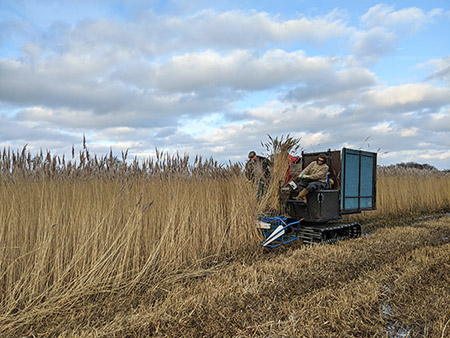
A low ground pressure, tracked reed harvester
Reed for thatching has to be cleaned to remove any grass and short pieces of reed. This is done by using a hand-held comb (dresser) or a machine powered band rake.
The cleaned reed is then tied into bundles with each bundle being 24” in circumference when tied 12” up from the base or butt end of the bundle. Each bundle is knocked onto a flat board to ensure the base of the reeds are even and ready for thatching.
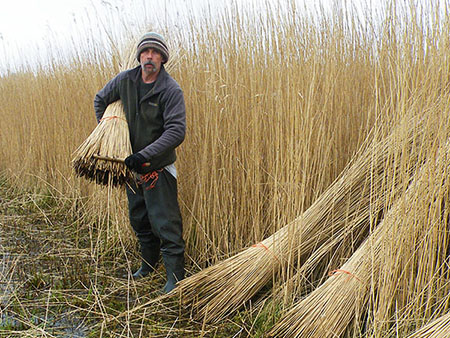
Cleaning reed with a dresser
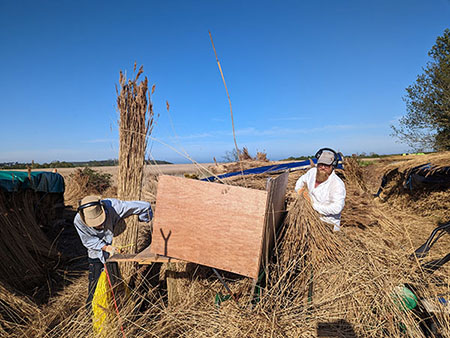
Cleaning and bundling reed
The finished bundles are either stacked or baled using steel banding. Each bale will contain 75 or 100 bundles and makes loading and unloading far quicker. Regardless of whether the reed is baled or loose, the bundles must be kept dry at all times.
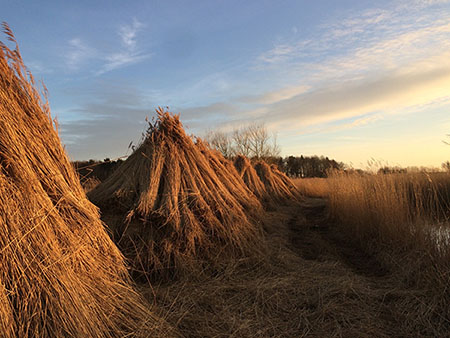
Stacks of reed
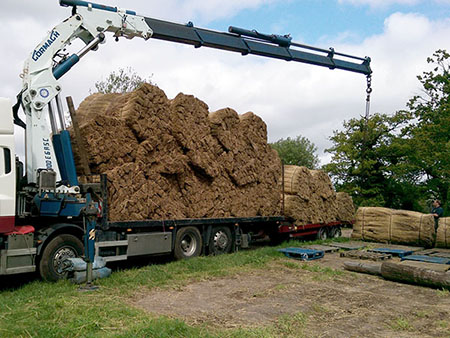
Loading bales of reed
Sedge (Cladium Mariscus) is harvested in The Broads on a 3 or 4 year rotation. Cutting takes place from mid-April through to the end of September depending on the water levels and is mostly done using small light- weight machines / reciprocating mowers.
Sedge contains a proportion of dead vegetation (litter) which is removed prior to tying into bunches. The standard bunch is 26” to 28” in circumference when tied green, however, each bunch will shrink as it dries. Sedge beds contain a variety of fen plants including reed, pin rush, lesser reed mace, parsley water dropwort, bog myrtle etc so customers have to expect some content of these plants in the tied bunches.
Cutting the sedge in the summer months suppresses any reed growth. Left uncut, sedge beds rapidly deteriorate with the accumulating dead vegetation restricting the variety of plants and resulting in sparse but thick long stems of pure sedge. Over time, scrub (sallow, birch, bog myrtle & alder) appear which in turn shade out the remaining sedge.
Unlike reed, the bunches of sedge are handled /loaded using pitch forks. Care has to be taken with sedge owing to the razor-sharp serrated edges. It is a remarkably tough but durable plant and used by thatchers for the ridging on roofs.
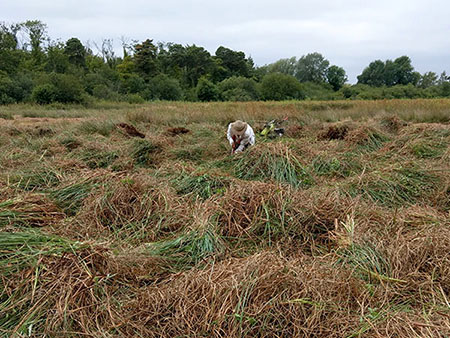
Sedge cutting
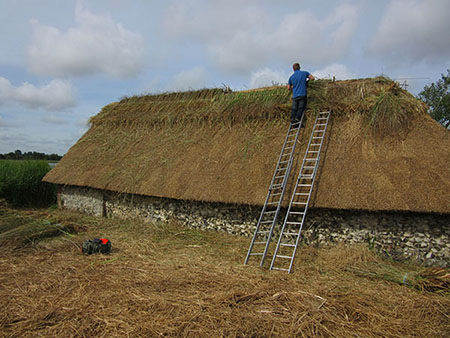
A thatcher using sedge on the ridge of a newly thatched roof
Cutters harvesting reed and sedge have been a traditional sight in Norfolk and Suffolk for generations. This historic and current mosaic of management creates the valued species and landscape of the Broads. The cut areas retain the rare saw sedge fens and create refuges for species such as crane and foraging areas for bittern as well as a host of other benefits. These benefits also include cleaning and absorbing water, creating local jobs and low carbon sustainable building materials produced in the UK.
Harvesting reed and sedge for thatching helps to maintain the open landscape and prevents natural succession, encroaching scrub and tree growth, taking place.
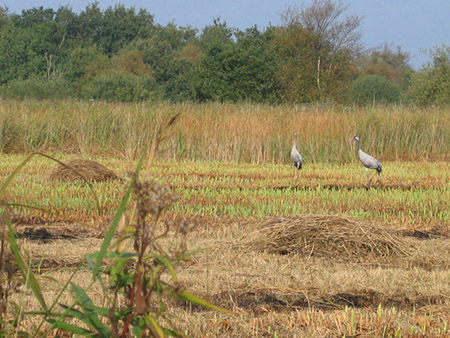
A pair of cranes on sedge stubble
The Broads remain the stronghold of Britain’s largest butterfly, the swallowtail, and the careful management of reed and sedge beds ensures that the swallowtail caterpillars are able to feed on milk parsley plants amongst the reed and sedge.
Reed beds also naturally filter water and can serve as storage areas for flood water.
A study by Hannah Millett in March 2023 revealed that 97.4% of the reed used by the U.K. thatching industry is imported. Imported reed originates in China, Ukraine, Turkey and Romania and arrives in the UK with a substantial carbon foot-print when compared to home grown reed.
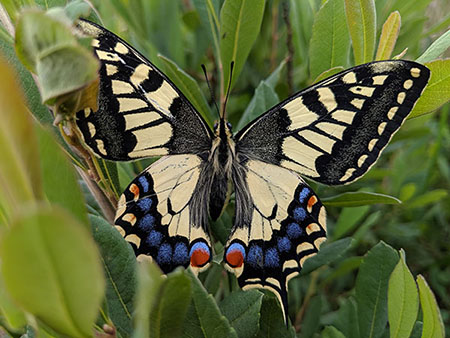
A swallowtail butterfly
The changing climate and in particular rising sea levels, will impact areas like the Broads. Hopefully, by working together, we can create new reed beds in suitable locations which will accommodate traditional reed cutting and provide new sites for wildlife.
Thatch is a traditional material that has been used for roofing in Norfolk since prehistory. Whereas in some parts of the country straw was used for thatch, the extensive reed beds of East Anglia gave our ancestors access to a much more durable, locally grown material. To this day most of the reed that is cut and bundled up in Norfolk is sold to thatchers.
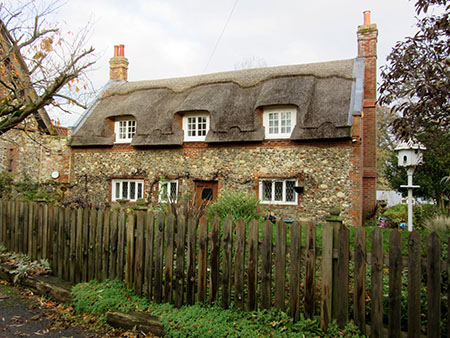
A cottage thatched with Norfolk Reed
Quality reed for thatching comes from reed beds which are cut every year or every two years. This is known as ‘single wale’ or double wale’ reed. Each bundle of reed is tied approximately 12” from the butt end and measures 24” to 26” circumference. A bundle of reed will cover about a square foot of roof.
It is estimated that 95% of the reed used for thatching in the UK comes from abroad. Local cutters have to compete with the imported supplies and some have to pay landowners a royalty to harvest the reed. Many reed bed owners qualify for grant aid to manage reedbeds. Sadly, some reed beds previously managed to produce reed for thatching are now cut on a longer rotation.
Norfolk Reed does, however, have some advantages over the competition.
If you are a homeowner needing to rethatch, a thatcher wanting to know more about our reed, or a builder researching traditional building materials we would like to hear from you.
If you require reed, sedge, need habitat restoration, scrub/tree removal, conservation management or advise then we will acknowledge your email and pass on your request to our Members.
The National Society of Master Thatchers
The East Anglia Master Thatchers Association
Royal Society for the Protection of Birds
For machinery advice, repairs etc, Brasca is happy to recommend Leon Kiddell. Mobile: 07908580661.
If you are thinking about starting reed or sedge cutting and wish to know more about training opportunities, then first download Brasca’s Training and Instruction Booklet on the link below. If possible, we may be able to put you in contact with an existing Reed Cutter who would be willing to demonstrate some cutting and discuss how to join the industry. Brasca advises all new entrants to undertake first aid, safe use of chainsaw and boat handling training courses. Please contact us for further information.